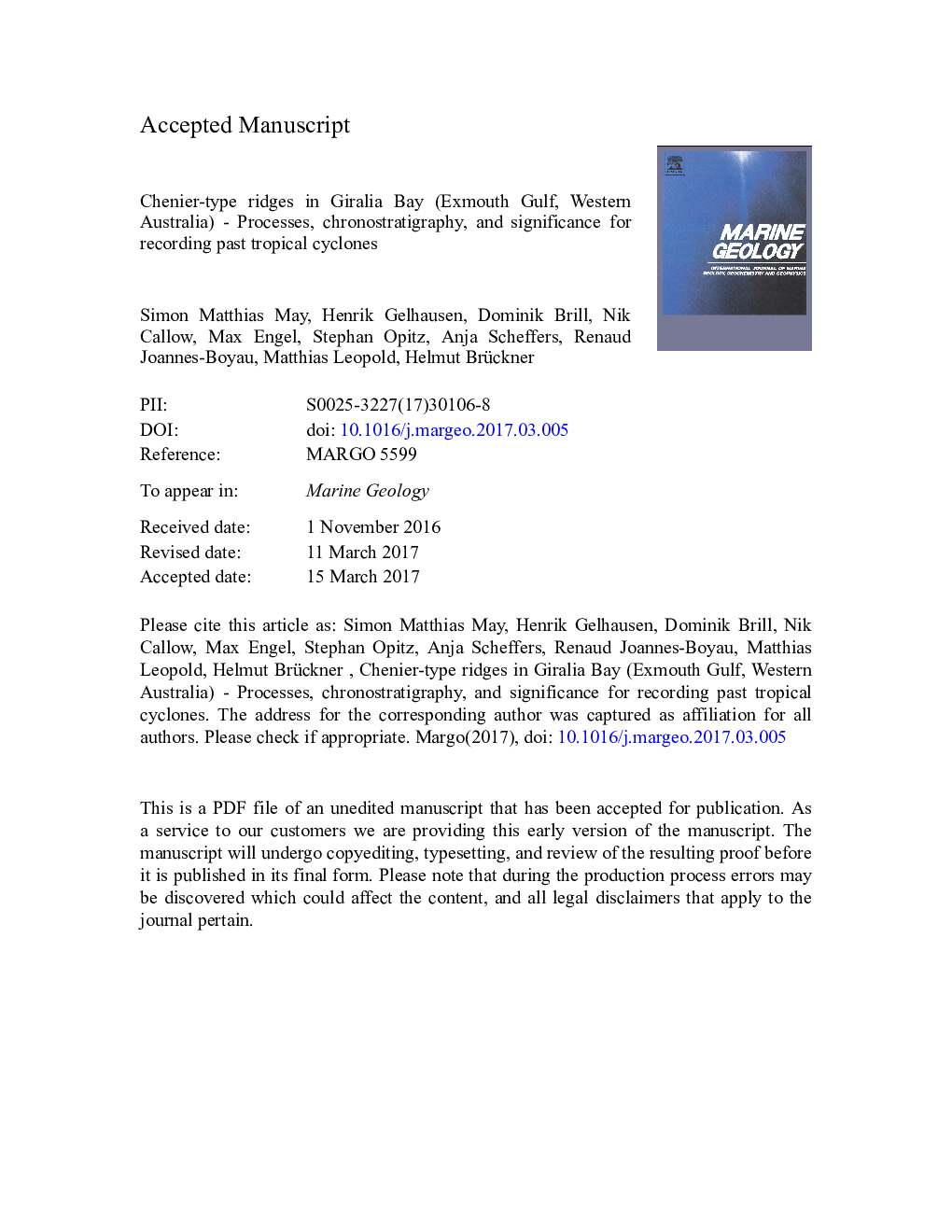| کد مقاله | کد نشریه | سال انتشار | مقاله انگلیسی | نسخه تمام متن |
|---|---|---|---|---|
| 8912032 | 1639056 | 2018 | 64 صفحه PDF | دانلود رایگان |
عنوان انگلیسی مقاله ISI
Chenier-type ridges in Giralia Bay (Exmouth Gulf, Western Australia) - Processes, chronostratigraphy, and significance for recording past tropical cyclones
دانلود مقاله + سفارش ترجمه
دانلود مقاله ISI انگلیسی
رایگان برای ایرانیان
کلمات کلیدی
موضوعات مرتبط
مهندسی و علوم پایه
علوم زمین و سیارات
ژئوشیمی و پترولوژی
پیش نمایش صفحه اول مقاله

چکیده انگلیسی
Past coastal flooding events may be inferred from geomorphic and sedimentary archives, including particular landforms (e.g., beach ridges, washover fans), deposits (e.g., washover sediments in lagoons) or erosional features (e.g., erosional scarps within strandplains). In Giralia Bay, southern Exmouth Gulf (Western Australia), sandy ridge sequences in supratidal elevations form the landward margin of extensive mudflats. The formation of these ridges is assumed to be mainly driven by tropical cyclones (TCs), although their depositional processes need to be clarified. We investigated the supratidal sandy ridge sequence in Giralia Bay by carrying out process monitoring, geomorphological mapping by means of an unmanned aerial vehicle survey, as well as sedimentological and geochronological investigations and multivariate statistics. Based on the resulting data, this study aims at (i) identifying the most important driving processes to form the sandy ridges; (ii) establishing their chronostratigraphy; and (iii) understanding their significance for recording past TC activity. Trench excavations revealed sandy units that are interbedded with mud layers at the base, similar to the present distal mudflat sediments. On top, mud intercalations recede, and sand layers of varying grain size distribution dominate. In the upper part of the trenches, younger sediment layers onlap older ones documenting the stepwise seaward accretion of the ridges onto the mudflat. While our data suggests that tidal processes have only limited effects on ridge activity, sediment transport, erosion and deposition seems to be driven by both TC-induced storm surges and high magnitude precipitation events causing surface discharge. Most accretionary sand units are thus assumed to represent events of morphodynamic activity during TC-induced flooding since the mid-Holocene. Ridge activity is recorded in a roughly decadal resolution and over historical as well as prehistorical/Holocene time scales. While the ridges do not represent beach or chenier ridges sensu stricto, they may be described as chenier-type ridges due to their stratigraphical architecture. Ridge evolution, however, over a millennial time scale seems to be indicated by the landward rise of the sequence possibly corresponding to the mid-Holocene sea-level highstand of Western Australia of at least 1-2Â m above present mean sea level.
ناشر
Database: Elsevier - ScienceDirect (ساینس دایرکت)
Journal: Marine Geology - Volume 396, 1 February 2018, Pages 186-204
Journal: Marine Geology - Volume 396, 1 February 2018, Pages 186-204
نویسندگان
Simon Matthias May, Henrik Gelhausen, Dominik Brill, John Nikolaus Callow, Max Engel, Stephan Opitz, Anja Scheffers, Renaud Joannes-Boyau, Matthias Leopold, Helmut Brückner,